Abstract
Photoreactive phospholipids have been used to probe the lipid interaction of diphtheria toxin. Low pH values induce the membrane insertion of both the binding and enzymic fragments of the toxin. The efficiency of this process is much higher with asolectin than with egg lecithin (phosphatidylcholine)/cholesterol liposomes. The low-pH-induced interaction of the toxin fragments with the membrane hydrocarbon phase is more evident for the enzymic A-chain than for the binding B-chain, and it is fully reversed by returning the pH to neutrality.
Full text
PDF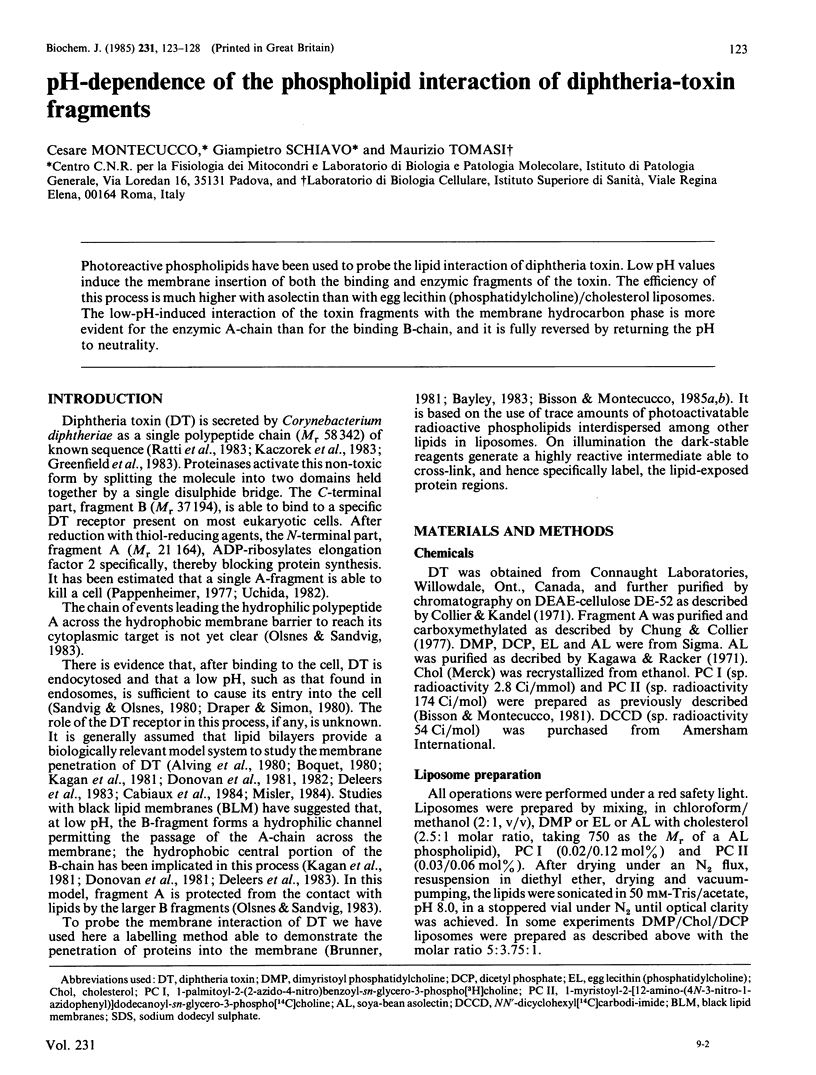
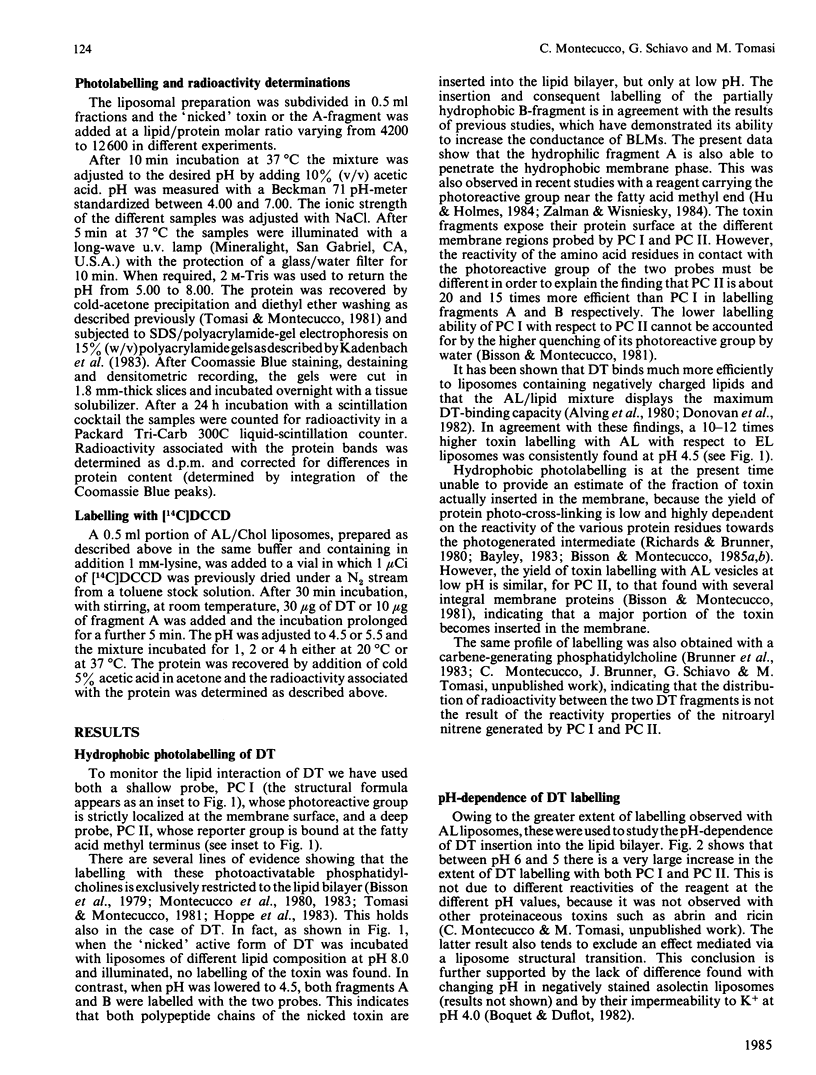
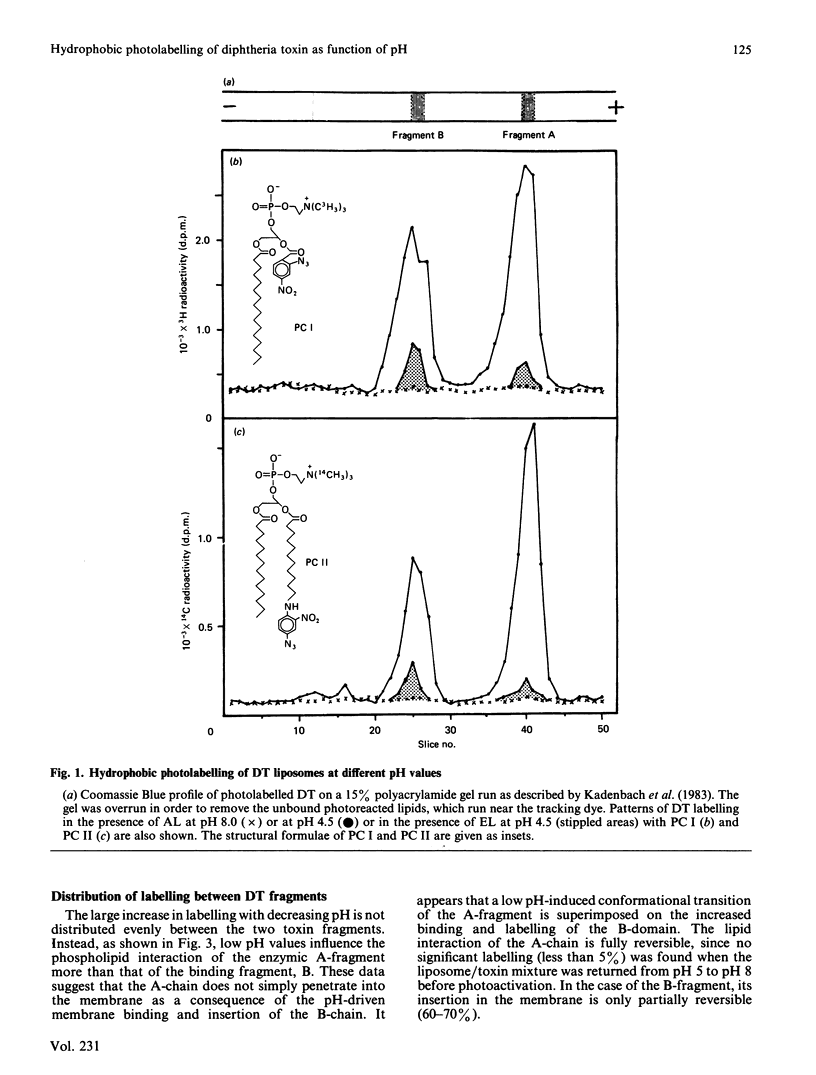
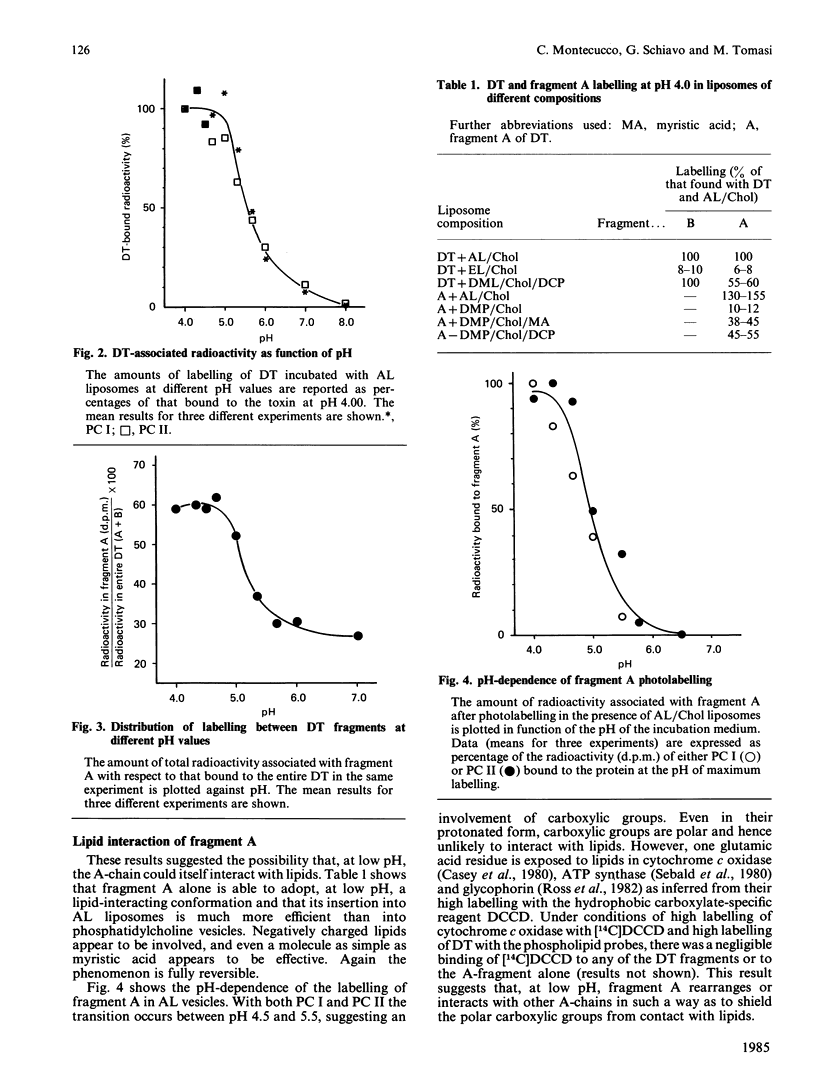
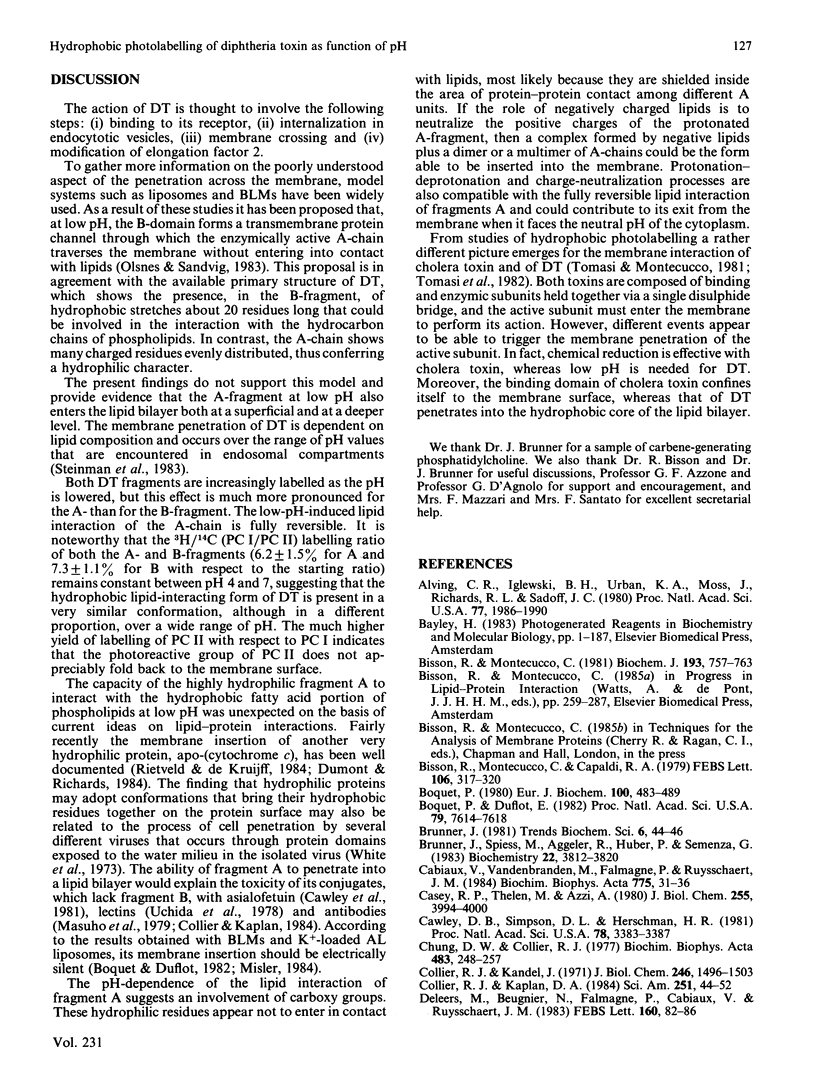
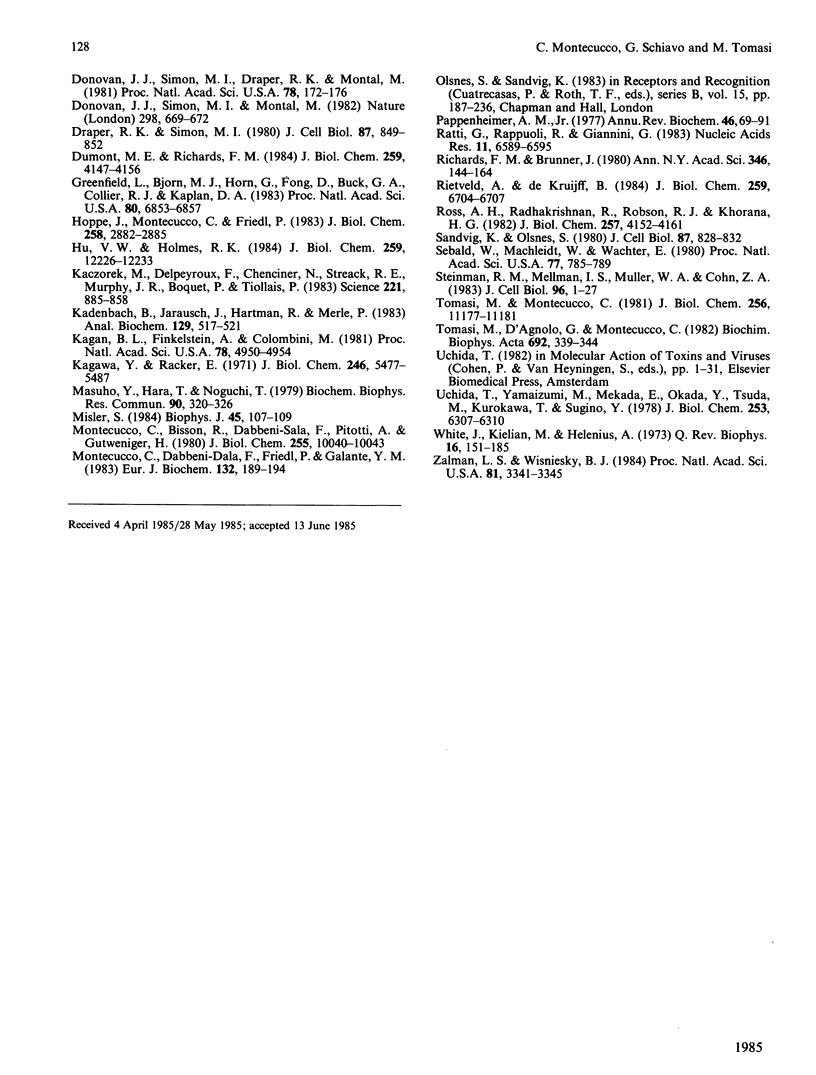
Selected References
These references are in PubMed. This may not be the complete list of references from this article.
- Alving C. R., Iglewski B. H., Urban K. A., Moss J., Richards R. L., Sadoff J. C. Binding of diphtheria toxin to phospholipids in liposomes. Proc Natl Acad Sci U S A. 1980 Apr;77(4):1986–1990. doi: 10.1073/pnas.77.4.1986. [DOI] [PMC free article] [PubMed] [Google Scholar]
- Bisson R., Montecucco C., Capaldi R. A. Interaction of membranous cytochrome b5 with arylazidophospholipids. FEBS Lett. 1979 Oct 15;106(2):317–320. doi: 10.1016/0014-5793(79)80523-2. [DOI] [PubMed] [Google Scholar]
- Bisson R., Montecucco C. Photolabelling of membrane proteins with photoactive phospholipids. Biochem J. 1981 Mar 1;193(3):757–763. doi: 10.1042/bj1930757. [DOI] [PMC free article] [PubMed] [Google Scholar]
- Boquet P., Duflot E. Tetanus toxin fragment forms channels in lipid vesicles at low pH. Proc Natl Acad Sci U S A. 1982 Dec;79(24):7614–7618. doi: 10.1073/pnas.79.24.7614. [DOI] [PMC free article] [PubMed] [Google Scholar]
- Boquet P. Interaction of diphtheria toxin fragments A, B and protein crm 45 with liposomes. Eur J Biochem. 1979 Oct 15;100(2):483–489. doi: 10.1111/j.1432-1033.1979.tb04192.x. [DOI] [PubMed] [Google Scholar]
- Brunner J., Spiess M., Aggeler R., Huber P., Semenza G. Hydrophobic labeling of a single leaflet of the human erythrocyte membrane. Biochemistry. 1983 Aug 2;22(16):3812–3820. doi: 10.1021/bi00285a016. [DOI] [PubMed] [Google Scholar]
- Cabiaux V., Vandenbranden M., Falmagne P., Ruysschaert J. M. Diphtheria toxin induces fusion of small unilamellar vesicles at low pH. Biochim Biophys Acta. 1984 Aug 8;775(1):31–36. doi: 10.1016/0005-2736(84)90231-1. [DOI] [PubMed] [Google Scholar]
- Casey R. P., Thelen M., Azzi A. Dicyclohexylcarbodiimide binds specifically and covalently to cytochrome c oxidase while inhibiting its H+-translocating activity. J Biol Chem. 1980 May 10;255(9):3994–4000. [PubMed] [Google Scholar]
- Cawley D. B., Simpson D. L., Herschman H. R. Asialoglycoprotein receptor mediates the toxic effects of an asialofetuin-diphtheria toxin fragment A conjugate on cultured rat hepatocytes. Proc Natl Acad Sci U S A. 1981 Jun;78(6):3383–3387. doi: 10.1073/pnas.78.6.3383. [DOI] [PMC free article] [PubMed] [Google Scholar]
- Chung D. W., Collier R. J. The mechanism of ADP-ribosylation of elongation factor 2 catalyzed by fragment A from diphtheria toxin. Biochim Biophys Acta. 1977 Aug 11;483(2):248–257. doi: 10.1016/0005-2744(77)90053-5. [DOI] [PubMed] [Google Scholar]
- Collier R. J., Kandel J. Structure and activity of diphtheria toxin. I. Thiol-dependent dissociation of a fraction of toxin into enzymically active and inactive fragments. J Biol Chem. 1971 Mar 10;246(5):1496–1503. [PubMed] [Google Scholar]
- Deleers M., Beugnier N., Falmagne P., Cabiaux V., Ruysschaert J. M. Localization in diphtheria toxin fragment B of a region that induces pore formation in planar lipid bilayers at low pH. FEBS Lett. 1983 Aug 22;160(1-2):82–86. doi: 10.1016/0014-5793(83)80941-7. [DOI] [PubMed] [Google Scholar]
- Donovan J. J., Simon M. I., Draper R. K., Montal M. Diphtheria toxin forms transmembrane channels in planar lipid bilayers. Proc Natl Acad Sci U S A. 1981 Jan;78(1):172–176. doi: 10.1073/pnas.78.1.172. [DOI] [PMC free article] [PubMed] [Google Scholar]
- Donovan J. J., Simon M. I., Montal M. Insertion of diphtheria toxin into and across membranes: role of phosphoinositide asymmetry. Nature. 1982 Aug 12;298(5875):669–672. doi: 10.1038/298669a0. [DOI] [PubMed] [Google Scholar]
- Draper R. K., Simon M. I. The entry of diphtheria toxin into the mammalian cell cytoplasm: evidence for lysosomal involvement. J Cell Biol. 1980 Dec;87(3 Pt 1):849–854. doi: 10.1083/jcb.87.3.849. [DOI] [PMC free article] [PubMed] [Google Scholar]
- Dumont M. E., Richards F. M. Insertion of apocytochrome c into lipid vesicles. J Biol Chem. 1984 Apr 10;259(7):4147–4156. [PubMed] [Google Scholar]
- Greenfield L., Bjorn M. J., Horn G., Fong D., Buck G. A., Collier R. J., Kaplan D. A. Nucleotide sequence of the structural gene for diphtheria toxin carried by corynebacteriophage beta. Proc Natl Acad Sci U S A. 1983 Nov;80(22):6853–6857. doi: 10.1073/pnas.80.22.6853. [DOI] [PMC free article] [PubMed] [Google Scholar]
- Hoppe J., Montecucco C., Friedl P. Labeling of subunit b of the ATP synthase from Escherichia coli with a photoreactive phospholipid analogue. J Biol Chem. 1983 Mar 10;258(5):2882–2885. [PubMed] [Google Scholar]
- Hu V. W., Holmes R. K. Evidence for direct insertion of fragments A and B of diphtheria toxin into model membranes. J Biol Chem. 1984 Oct 10;259(19):12226–12233. [PubMed] [Google Scholar]
- Kaczorek M., Delpeyroux F., Chenciner N., Streeck R. E., Murphy J. R., Boquet P., Tiollais P. Nucleotide sequence and expression of the diphtheria tox228 gene in Escherichia coli. Science. 1983 Aug 26;221(4613):855–858. doi: 10.1126/science.6348945. [DOI] [PubMed] [Google Scholar]
- Kadenbach B., Jarausch J., Hartmann R., Merle P. Separation of mammalian cytochrome c oxidase into 13 polypeptides by a sodium dodecyl sulfate-gel electrophoretic procedure. Anal Biochem. 1983 Mar;129(2):517–521. doi: 10.1016/0003-2697(83)90586-9. [DOI] [PubMed] [Google Scholar]
- Kagan B. L., Finkelstein A., Colombini M. Diphtheria toxin fragment forms large pores in phospholipid bilayer membranes. Proc Natl Acad Sci U S A. 1981 Aug;78(8):4950–4954. doi: 10.1073/pnas.78.8.4950. [DOI] [PMC free article] [PubMed] [Google Scholar]
- Masuho Y., Hara T., Noguchi T. Preparation of a hybrid of fragment Fab' of antibody and fragment A of diphtheria toxin and its cytotoxicity. Biochem Biophys Res Commun. 1979 Sep 12;90(1):320–326. doi: 10.1016/0006-291x(79)91627-9. [DOI] [PubMed] [Google Scholar]
- Montecucco C., Bisson R., Dabbeni-Sala F., Pitotti A., Gutweniger H. Interaction of the mitochondrial ATPase complex with phospholipids. J Biol Chem. 1980 Nov 10;255(21):10040–10041. [PubMed] [Google Scholar]
- Montecucco C., Dabbeni-Sala F., Friedl P., Galante Y. M. Membrane topology of ATP synthase from bovine heart mitochondria and Escherichia coli. Eur J Biochem. 1983 Apr 15;132(1):189–194. doi: 10.1111/j.1432-1033.1983.tb07346.x. [DOI] [PubMed] [Google Scholar]
- Pappenheimer A. M., Jr Diphtheria toxin. Annu Rev Biochem. 1977;46:69–94. doi: 10.1146/annurev.bi.46.070177.000441. [DOI] [PubMed] [Google Scholar]
- Preston S. H. Children and the elderly in the U.S. Sci Am. 1984 Dec;251(6):44–57. doi: 10.1038/scientificamerican1284-44. [DOI] [PubMed] [Google Scholar]
- RUBINSTEIN D., RABINOWITCH E. ACTION SPECTRUM FOR THE APPEARANCE OF THE 520 MILLIMICRON DIFFERENCE BAND IN ILLUMINATED CHLORELLA CELLS. Biophys J. 1964 Mar;4:107–113. doi: 10.1016/s0006-3495(64)86772-2. [DOI] [PMC free article] [PubMed] [Google Scholar]
- Ratti G., Rappuoli R., Giannini G. The complete nucleotide sequence of the gene coding for diphtheria toxin in the corynephage omega (tox+) genome. Nucleic Acids Res. 1983 Oct 11;11(19):6589–6595. doi: 10.1093/nar/11.19.6589. [DOI] [PMC free article] [PubMed] [Google Scholar]
- Rietveld A., de Kruijff B. Is the mitochondrial precursor protein apocytochrome c able to pass a lipid barrier? J Biol Chem. 1984 Jun 10;259(11):6704–6707. [PubMed] [Google Scholar]
- Ross A. H., Radhakrishnan R., Robson R. J., Khorana H. G. The transmembrane domain of glycophorin A as studied by cross-linking using photoactivatable phospholipids. J Biol Chem. 1982 Apr 25;257(8):4152–4161. [PubMed] [Google Scholar]
- Sandvig K., Olsnes S. Diphtheria toxin entry into cells is facilitated by low pH. J Cell Biol. 1980 Dec;87(3 Pt 1):828–832. doi: 10.1083/jcb.87.3.828. [DOI] [PMC free article] [PubMed] [Google Scholar]
- Sebald W., Machleidt W., Wachter E. N,N'-dicyclohexylcarbodiimide binds specifically to a single glutamyl residue of the proteolipid subunit of the mitochondrial adenosinetriphosphatases from Neurospora crassa and Saccharomyces cerevisiae. Proc Natl Acad Sci U S A. 1980 Feb;77(2):785–789. doi: 10.1073/pnas.77.2.785. [DOI] [PMC free article] [PubMed] [Google Scholar]
- Steinman R. M., Mellman I. S., Muller W. A., Cohn Z. A. Endocytosis and the recycling of plasma membrane. J Cell Biol. 1983 Jan;96(1):1–27. doi: 10.1083/jcb.96.1.1. [DOI] [PMC free article] [PubMed] [Google Scholar]
- Tomasi M., D'Agnolo G., Montecucco C. Micellar gangliosides mediate the lipid insertion of cholera toxin protomer A. Biochim Biophys Acta. 1982 Nov 22;692(3):339–344. doi: 10.1016/0005-2736(82)90382-0. [DOI] [PubMed] [Google Scholar]
- Tomasi M., Montecucco C. Lipid insertion of cholera toxin after binding to GM1-containing liposomes. J Biol Chem. 1981 Nov 10;256(21):11177–11181. [PubMed] [Google Scholar]
- Uchida T., Yamaizumi M., Mekada E., Okada Y., Tsuda M., Kurokawa T., Sugino Y. Reconstitution of hybrid toxin from Fragment A of diphtheria toxin and a subunit of Wistaria floribunda lectin. J Biol Chem. 1978 Sep 25;253(18):6307–6310. [PubMed] [Google Scholar]
- White J., Kielian M., Helenius A. Membrane fusion proteins of enveloped animal viruses. Q Rev Biophys. 1983 May;16(2):151–195. doi: 10.1017/s0033583500005072. [DOI] [PubMed] [Google Scholar]
- Zalman L. S., Wisnieski B. J. Mechanism of insertion of diphtheria toxin: peptide entry and pore size determinations. Proc Natl Acad Sci U S A. 1984 Jun;81(11):3341–3345. doi: 10.1073/pnas.81.11.3341. [DOI] [PMC free article] [PubMed] [Google Scholar]


